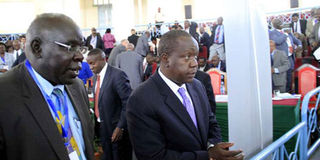Commission to get varsity education back on track

Commission for University Education Secretary David Some (left) and the Cabinet Secretary for Education Science and Technology, Fred Matiang'i, at a past event. PHOTO | FILE | NATION MEDIA GROUP
What you need to know:
- A recent investigation of Kisii University through a ministerial directive revealed the institution had breached so many regulations.
- Kisii University has established so many campuses without the knowledge, let alone the approval of the council and chancellor.
- In the countdown to the elections; the question is, what plans do the various political parties have for the revitalisation and expansion of universities.
- Expansion of universities is a progressive development for a growing economy like Kenya’s.
Since last month, the Commission for University Education has been conducting an audit of all universities to ascertain whether or not they meet quality standards.
It may look spurious why a regulator should, so to speak, intrude into the affairs of universities, which ordinarily are independent and run by autonomous councils and senates. But yes, that exercise is critical in as much as it looks patronising.
Most universities have deviated from their core missions of teaching, research and community service to become business enterprises. In some cases, particularly for the public, they are parastatals where the chief gives jobs and tenders to homeboys. For example, a recent investigation of Kisii University through a ministerial directive, revealed just that.
The university was found to have breached so many regulations. First, it had established so many campuses, which basically are centres for enterprise, without the knowledge, let alone the approval of the council and chancellor. Yet more horrifying is that in one the campuses in Eldoret, it had enrolled some 76 doctoral students while it had only two lecturers with PhD. Even worse, one of the PhDs was being contested, having been attained irregularly.
Clearly, evidence by the special advisory committee that had been appointed by Education Cabinet Secretary Fred Matiang’i returned a verdict of guilt on the universities. The advisory team averred that most universities were in dire straits and were essentially dysfunctional.
EXAMINING UNIVERSITIES
The audit was led by Prof Crispus Kiamba, a former vice-chancellor of the University of Nairobi and had two other members, Prof George Magoha, also a former VC of the University of Nairobi and Prof Patricia Kameri-Mbote of the UoN’s Law School.
Debate on the country’s education would be incomplete without examining universities. In the countdown to the elections; the question is, what plans do the various political parties have for the revitalisation and expansion of universities as well as other tertiary institutions.
The growth of universities has been quite dramatic in recent years. Whereas the country operated only one university for more than a decade – University of Nairobi – the rate of growth in the past two decades has been phenomenal.
In his last months in office in 2013, President Mwai Kibaki awarded charters to some 15 university colleges, elevating them to full-fledged public universities. Thus, the number of public universities rose from the previous seven to 22. Simultaneously, he awarded charters to private universities such that by the time he left office, the county had more than 60 universities. This has since grown to 70.
Expansion of universities is a progressive development for a growing economy like Kenya’s. It offers opportunities to high school leavers to transit to higher education and through that, create a pool of human resource to drive the engines of the economy.
Statistically, there were some 539,749 students enrolled in the public and private universities during the 2015/16 academic year, the bulk being in public universities.
Although enrolments have grown exponentially, still many eligible candidates are locked out. And arising from the performance of last year’s Kenya Certificate of Secondary Education (KCSE) results, a paltry 15 per cent will join universities, down from the previous 30 per cent.
The expansion and growth has inherent challenges and paradoxes. While the number of students joining universities has been increasing in absolute terms, until last year, the actual number of the eligible in the cohort – those who joined Standard One with the qualifiers and finally made it – is fewer.
SHORTAGE OF FACILITIES
Second, expansion has not been matched with resources. Universities perennially suffer shortage of facilities and worse, lecturers, who are overworked and underpaid. The current strike by lecturers is an apt illustration of the poor state of universities.
Third, universities tend to duplicate programmes and courses, creating a scenario of huge supply of graduates who cannot be employed. Statistics by the Commission for University Education show that a majority of students are enrolled in the humanities and social sciences, while engineering, natural sciences and medicine are under-enrolled.
Fourth, despite increased student population, funding to public universities remain minimal and is based on an old model, which has since been overtaken by time. Each student is allocated Sh120,000 a year irrespective of the cost of mounting the course. This poses serious challenge to disciplines like medicine, which are capital intensive.
Fortunately, the government has now accepted, in principle, to change the funding model and base it on unit cost, meaning those requiring a lot of money will be given money capitation compared to the rest.
Broadly, the challenges facing university education are: inadequate funding; lack of facilities; few and lowly paid lecturers; duplication of programmes; poor governance and dearth of research and innovation.
The onus is the political parties that seek to form the next government to examine existing policies, legal frameworks and funding models and prepare a marshal plan to revitalise the universities and set them apart as centres of academic excellence and research.


